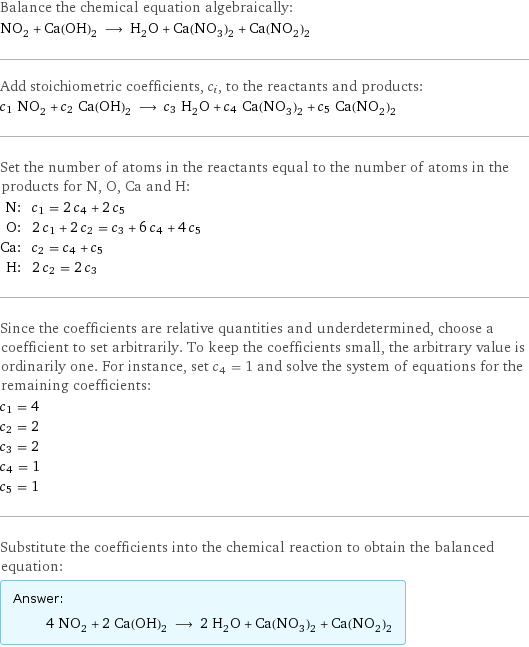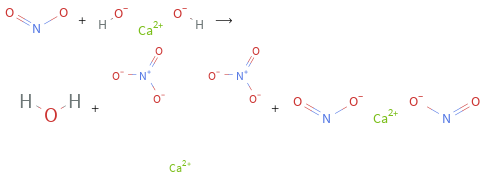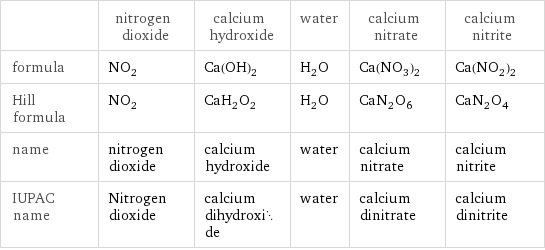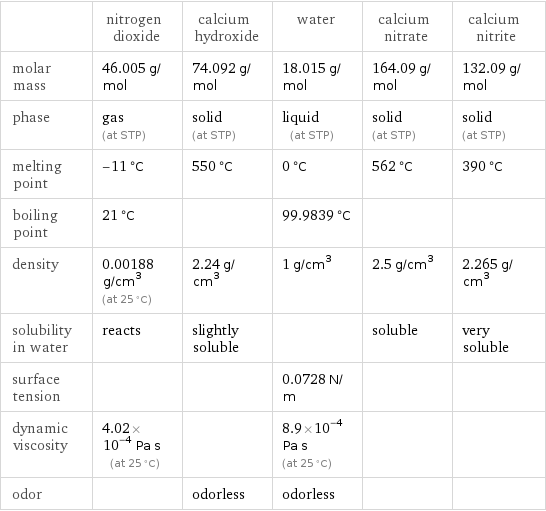Input interpretation

NO_2 nitrogen dioxide + Ca(OH)_2 calcium hydroxide ⟶ H_2O water + Ca(NO_3)_2 calcium nitrate + Ca(NO_2)_2 calcium nitrite
Balanced equation

Balance the chemical equation algebraically: NO_2 + Ca(OH)_2 ⟶ H_2O + Ca(NO_3)_2 + Ca(NO_2)_2 Add stoichiometric coefficients, c_i, to the reactants and products: c_1 NO_2 + c_2 Ca(OH)_2 ⟶ c_3 H_2O + c_4 Ca(NO_3)_2 + c_5 Ca(NO_2)_2 Set the number of atoms in the reactants equal to the number of atoms in the products for N, O, Ca and H: N: | c_1 = 2 c_4 + 2 c_5 O: | 2 c_1 + 2 c_2 = c_3 + 6 c_4 + 4 c_5 Ca: | c_2 = c_4 + c_5 H: | 2 c_2 = 2 c_3 Since the coefficients are relative quantities and underdetermined, choose a coefficient to set arbitrarily. To keep the coefficients small, the arbitrary value is ordinarily one. For instance, set c_4 = 1 and solve the system of equations for the remaining coefficients: c_1 = 4 c_2 = 2 c_3 = 2 c_4 = 1 c_5 = 1 Substitute the coefficients into the chemical reaction to obtain the balanced equation: Answer: | | 4 NO_2 + 2 Ca(OH)_2 ⟶ 2 H_2O + Ca(NO_3)_2 + Ca(NO_2)_2
Structures

+ ⟶ + +
Names

nitrogen dioxide + calcium hydroxide ⟶ water + calcium nitrate + calcium nitrite
Equilibrium constant
![Construct the equilibrium constant, K, expression for: NO_2 + Ca(OH)_2 ⟶ H_2O + Ca(NO_3)_2 + Ca(NO_2)_2 Plan: • Balance the chemical equation. • Determine the stoichiometric numbers. • Assemble the activity expression for each chemical species. • Use the activity expressions to build the equilibrium constant expression. Write the balanced chemical equation: 4 NO_2 + 2 Ca(OH)_2 ⟶ 2 H_2O + Ca(NO_3)_2 + Ca(NO_2)_2 Assign stoichiometric numbers, ν_i, using the stoichiometric coefficients, c_i, from the balanced chemical equation in the following manner: ν_i = -c_i for reactants and ν_i = c_i for products: chemical species | c_i | ν_i NO_2 | 4 | -4 Ca(OH)_2 | 2 | -2 H_2O | 2 | 2 Ca(NO_3)_2 | 1 | 1 Ca(NO_2)_2 | 1 | 1 Assemble the activity expressions accounting for the state of matter and ν_i: chemical species | c_i | ν_i | activity expression NO_2 | 4 | -4 | ([NO2])^(-4) Ca(OH)_2 | 2 | -2 | ([Ca(OH)2])^(-2) H_2O | 2 | 2 | ([H2O])^2 Ca(NO_3)_2 | 1 | 1 | [Ca(NO3)2] Ca(NO_2)_2 | 1 | 1 | [Ca(NO2)2] The equilibrium constant symbol in the concentration basis is: K_c Mulitply the activity expressions to arrive at the K_c expression: Answer: | | K_c = ([NO2])^(-4) ([Ca(OH)2])^(-2) ([H2O])^2 [Ca(NO3)2] [Ca(NO2)2] = (([H2O])^2 [Ca(NO3)2] [Ca(NO2)2])/(([NO2])^4 ([Ca(OH)2])^2)](../image_source/d1f817fb9d25fef7810e38dccfd50211.png)
Construct the equilibrium constant, K, expression for: NO_2 + Ca(OH)_2 ⟶ H_2O + Ca(NO_3)_2 + Ca(NO_2)_2 Plan: • Balance the chemical equation. • Determine the stoichiometric numbers. • Assemble the activity expression for each chemical species. • Use the activity expressions to build the equilibrium constant expression. Write the balanced chemical equation: 4 NO_2 + 2 Ca(OH)_2 ⟶ 2 H_2O + Ca(NO_3)_2 + Ca(NO_2)_2 Assign stoichiometric numbers, ν_i, using the stoichiometric coefficients, c_i, from the balanced chemical equation in the following manner: ν_i = -c_i for reactants and ν_i = c_i for products: chemical species | c_i | ν_i NO_2 | 4 | -4 Ca(OH)_2 | 2 | -2 H_2O | 2 | 2 Ca(NO_3)_2 | 1 | 1 Ca(NO_2)_2 | 1 | 1 Assemble the activity expressions accounting for the state of matter and ν_i: chemical species | c_i | ν_i | activity expression NO_2 | 4 | -4 | ([NO2])^(-4) Ca(OH)_2 | 2 | -2 | ([Ca(OH)2])^(-2) H_2O | 2 | 2 | ([H2O])^2 Ca(NO_3)_2 | 1 | 1 | [Ca(NO3)2] Ca(NO_2)_2 | 1 | 1 | [Ca(NO2)2] The equilibrium constant symbol in the concentration basis is: K_c Mulitply the activity expressions to arrive at the K_c expression: Answer: | | K_c = ([NO2])^(-4) ([Ca(OH)2])^(-2) ([H2O])^2 [Ca(NO3)2] [Ca(NO2)2] = (([H2O])^2 [Ca(NO3)2] [Ca(NO2)2])/(([NO2])^4 ([Ca(OH)2])^2)
Rate of reaction
![Construct the rate of reaction expression for: NO_2 + Ca(OH)_2 ⟶ H_2O + Ca(NO_3)_2 + Ca(NO_2)_2 Plan: • Balance the chemical equation. • Determine the stoichiometric numbers. • Assemble the rate term for each chemical species. • Write the rate of reaction expression. Write the balanced chemical equation: 4 NO_2 + 2 Ca(OH)_2 ⟶ 2 H_2O + Ca(NO_3)_2 + Ca(NO_2)_2 Assign stoichiometric numbers, ν_i, using the stoichiometric coefficients, c_i, from the balanced chemical equation in the following manner: ν_i = -c_i for reactants and ν_i = c_i for products: chemical species | c_i | ν_i NO_2 | 4 | -4 Ca(OH)_2 | 2 | -2 H_2O | 2 | 2 Ca(NO_3)_2 | 1 | 1 Ca(NO_2)_2 | 1 | 1 The rate term for each chemical species, B_i, is 1/ν_i(Δ[B_i])/(Δt) where [B_i] is the amount concentration and t is time: chemical species | c_i | ν_i | rate term NO_2 | 4 | -4 | -1/4 (Δ[NO2])/(Δt) Ca(OH)_2 | 2 | -2 | -1/2 (Δ[Ca(OH)2])/(Δt) H_2O | 2 | 2 | 1/2 (Δ[H2O])/(Δt) Ca(NO_3)_2 | 1 | 1 | (Δ[Ca(NO3)2])/(Δt) Ca(NO_2)_2 | 1 | 1 | (Δ[Ca(NO2)2])/(Δt) (for infinitesimal rate of change, replace Δ with d) Set the rate terms equal to each other to arrive at the rate expression: Answer: | | rate = -1/4 (Δ[NO2])/(Δt) = -1/2 (Δ[Ca(OH)2])/(Δt) = 1/2 (Δ[H2O])/(Δt) = (Δ[Ca(NO3)2])/(Δt) = (Δ[Ca(NO2)2])/(Δt) (assuming constant volume and no accumulation of intermediates or side products)](../image_source/28c679fe242e74d38ca3e7345744f46b.png)
Construct the rate of reaction expression for: NO_2 + Ca(OH)_2 ⟶ H_2O + Ca(NO_3)_2 + Ca(NO_2)_2 Plan: • Balance the chemical equation. • Determine the stoichiometric numbers. • Assemble the rate term for each chemical species. • Write the rate of reaction expression. Write the balanced chemical equation: 4 NO_2 + 2 Ca(OH)_2 ⟶ 2 H_2O + Ca(NO_3)_2 + Ca(NO_2)_2 Assign stoichiometric numbers, ν_i, using the stoichiometric coefficients, c_i, from the balanced chemical equation in the following manner: ν_i = -c_i for reactants and ν_i = c_i for products: chemical species | c_i | ν_i NO_2 | 4 | -4 Ca(OH)_2 | 2 | -2 H_2O | 2 | 2 Ca(NO_3)_2 | 1 | 1 Ca(NO_2)_2 | 1 | 1 The rate term for each chemical species, B_i, is 1/ν_i(Δ[B_i])/(Δt) where [B_i] is the amount concentration and t is time: chemical species | c_i | ν_i | rate term NO_2 | 4 | -4 | -1/4 (Δ[NO2])/(Δt) Ca(OH)_2 | 2 | -2 | -1/2 (Δ[Ca(OH)2])/(Δt) H_2O | 2 | 2 | 1/2 (Δ[H2O])/(Δt) Ca(NO_3)_2 | 1 | 1 | (Δ[Ca(NO3)2])/(Δt) Ca(NO_2)_2 | 1 | 1 | (Δ[Ca(NO2)2])/(Δt) (for infinitesimal rate of change, replace Δ with d) Set the rate terms equal to each other to arrive at the rate expression: Answer: | | rate = -1/4 (Δ[NO2])/(Δt) = -1/2 (Δ[Ca(OH)2])/(Δt) = 1/2 (Δ[H2O])/(Δt) = (Δ[Ca(NO3)2])/(Δt) = (Δ[Ca(NO2)2])/(Δt) (assuming constant volume and no accumulation of intermediates or side products)
Chemical names and formulas

| nitrogen dioxide | calcium hydroxide | water | calcium nitrate | calcium nitrite formula | NO_2 | Ca(OH)_2 | H_2O | Ca(NO_3)_2 | Ca(NO_2)_2 Hill formula | NO_2 | CaH_2O_2 | H_2O | CaN_2O_6 | CaN_2O_4 name | nitrogen dioxide | calcium hydroxide | water | calcium nitrate | calcium nitrite IUPAC name | Nitrogen dioxide | calcium dihydroxide | water | calcium dinitrate | calcium dinitrite
Substance properties

| nitrogen dioxide | calcium hydroxide | water | calcium nitrate | calcium nitrite molar mass | 46.005 g/mol | 74.092 g/mol | 18.015 g/mol | 164.09 g/mol | 132.09 g/mol phase | gas (at STP) | solid (at STP) | liquid (at STP) | solid (at STP) | solid (at STP) melting point | -11 °C | 550 °C | 0 °C | 562 °C | 390 °C boiling point | 21 °C | | 99.9839 °C | | density | 0.00188 g/cm^3 (at 25 °C) | 2.24 g/cm^3 | 1 g/cm^3 | 2.5 g/cm^3 | 2.265 g/cm^3 solubility in water | reacts | slightly soluble | | soluble | very soluble surface tension | | | 0.0728 N/m | | dynamic viscosity | 4.02×10^-4 Pa s (at 25 °C) | | 8.9×10^-4 Pa s (at 25 °C) | | odor | | odorless | odorless | |
Units
